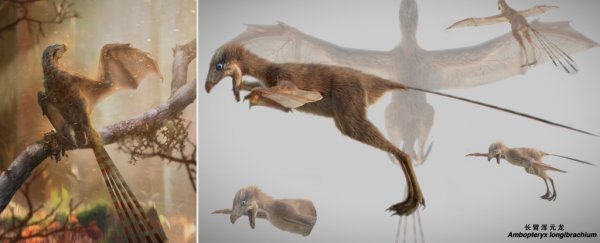In recent years, it's emerged that some dinosaurs - considered scaly and reptilian for many years - were actually wearing feathers. But a newly discovered species of scansoriopterygid dinosaur sports a different style. This tiny creature had bat-like wings: leathery, not feathery.
It's called Ambopteryx longibrachium, and it was just 33 centimetres (13 inches) long. The flying animal lived 163 million years ago, smack-bang in the middle of the Jurassic in what is now Liaoning Province, China.
Its remains show us that flight in dinosaurs was definitely evolving in different forms.
There are several species of scansoriopterygid dinosaur. They were tiny non-avian animals about the size of small parrots, belonging to the same theropod suborder that also encompasses the mighty tyrannosaurs.
Typically, scansoriopterygids are reconstructed with feathered wings, but in 2015, palaeontologists in China found a species they named Yi qi that had an elongated digit extending from the wrist; it's called a styliform and the feature is more typical of a bat than a bird.
This was the first time such a wing had been seen in theropods, as opposed to pterosaurs or bats. But Y. qi was just one specimen, and not everyone was convinced.
A. longibrachium, therefore, adds considerable support to the notion of parallel evolution of flight.
It has a similar bone structure, with a membrane-supporting styliform, but it's clearly not the same animal as Y. qi either. It has a wider and longer forelimb, and a short tail with fused vertebrae at the end.
Obviously, no birds exist with this type of wing today, or even survived into the Cretaceous. This means it was likely a short-lived evolutionary experiment that ultimately lost out to the feathered variety, the researchers noted in their paper.
The research has been published in Nature.
